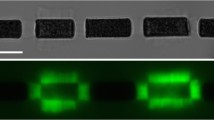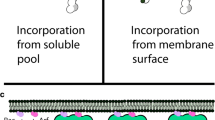Abstract.
Actin filaments form rings and loops when >20 mM divalent cations are added to very dilute solutions of phalloidin-stabilized filamentous actin (F-actin). Some rings consist of very long single actin filaments partially overlapping at their ends, and others are formed by small numbers of filaments associated laterally. In some cases, undulations of the rings are observed with amplitudes and dynamics similar to those of the thermal motions of single actin filaments. Lariat-shaped aggregates also co-exist with rings and rodlike bundles. These polyvalent cation-induced actin rings are analogous to the toroids of DNA formed by addition of polyvalent cations, but the much larger diameter of actin rings reflects the greater bending stiffness of F-actin. Actin rings can also be formed by addition of streptavidin to crosslink sparsely biotinylated F-actin at very low concentrations. The energy of bending in a ring, calculated from the persistence length of F-actin and the ring diameter, provides an estimate for the adhesion energy mediated by the multivalent counterions, or due to the streptavidin-biotin bonds, required to keep the ring closed.
Similar content being viewed by others
Author information
Authors and Affiliations
Additional information
Revised version: 19 July 2001
Electronic Publication
Rights and permissions
About this article
Cite this article
Tang, J.X., Käs, J.A., Shah, J.V. et al. Counterion-induced actin ring formation. Eur Biophys J Biophy 30, 477–484 (2001). https://doi.org/10.1007/s002490100178
Received:
Accepted:
Issue Date:
DOI: https://doi.org/10.1007/s002490100178




